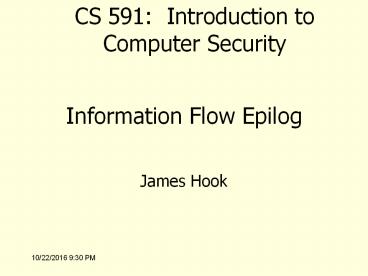Information Flow Epilog - PowerPoint PPT Presentation
Title:
Information Flow Epilog
Description:
CS 591: Introduction to Computer Security Information Flow Epilog James Hook – PowerPoint PPT presentation
Number of Views:50
Avg rating:3.0/5.0
Title: Information Flow Epilog
1
Information Flow Epilog
CS 591 Introduction to Computer Security
- James Hook
2
Last time
- Information flow security
- Denning and Denning as presented in Chapter 15
- Flow Caml nutshell paper
- Compilation can be made aware of confidentiality
levels - Levels must be identified
- Levels can be tracked through computational
effects environment, state, control,
exceptions, concurrency (Not shown in Flow Caml)
3
Does it work?
- Theoretical results
- Volpano, Irvine and Smith (JCS 96) showed
Soundness - If an expression e can be given a type t in our
system, then Simple Security says that only
variables at level t or lower in e will have
their contents read when e is evaluated (no read
up). On the other hand, if a command c can be
given a type t cmd then Confinement says that
no variable below level t is updated in c (no
write down). - Using modern language theory the techniques in
Flow Caml and similar systems can be proven sound
4
Does it work?
- In practice it is not broadly adopted
- Technical issue is the complexity of managing
policy - I suspect there are social issues as well the
technical issues are not show stoppers
5
Recall
- Consider an example (in no particular language)
- Assume H is high and L is Low
H readHighDatabase() L readLowUserInput() If
f(H,L) then printLow Success else printLow
Fail
6
But!!!
- Consider an example (in no particular language)
- We do this every day!
H readHighDatabase(passwd) L
readLowUserInput() If checkPassword(H,L) then
printLow Success else printLow Fail
7
Password checking paradox
- Why shouldnt we allow someone to write the
password program? - Why should we?
8
Policy
- The password paradox is solved by explicit policy
- Similar issues arise with crypto algorithms
- LoCypher encrypt (HighClear, goodKey)
- Cf.
- LoCypher encrypt (HighClear, badKey)
9
FlowCaml and Policy
- FlowCaml solves the policy problem by dividing
the program into two parts - Flow caml portion (.fml), with all flows checked
- Regular caml portion with an annotated interface
- The downgrading of encryption or password
validation queries is not done within the
flow-checked portion
10
Policy
- Zdancewic uses other techniques, including
explicit downgrade assertions for confidentiality - Basic philosophy uniform enforcement with
explicit escape mechanism - Focus analysis on the exceptions
11
Further reading
- Dorothy E. Denning and Peter J. Denning,
Certification of Programs for Secure Information
Flow, http//www.seas.upenn.edu/cis670/Spring2003
/p504-denning.pdf - Dennis Volpano, Geoffrey Smith, and Cynthia
Irvine, A Sound Type System for Secure Flow
Analysis, http//www.cs.fiu.edu/smithg/papers/jcs
96.pdf - Steve Zdancewic, Lantian Zheng, Nathaniel
Nystrom, and Andrew C. Myers, Secure Program
Partitioning, http//www.cis.upenn.edu/stevez/pap
ers/ZZNM02.pdf - Andrei Sabelfeld and Andrew C. Myers,
Language-based Information-Flow Security,
http//www.cs.cornell.edu/andru/papers/jsac/sm-jsa
c03.pdf - Peng Li and Steve Zdancewic, Downgrading Policies
and Relaxed Noninterference, http//www.cis.upenn.
edu/stevez/papers/LZ05a.pdf































